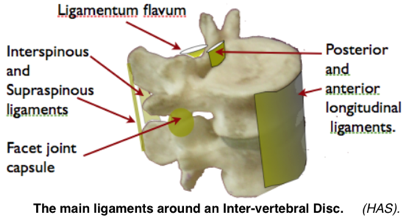 Natural selection has resulted in lordotic curves to achieve a bipedal, upright (orthograde) stance in humans. This has the added advantage of protecting the IV Disc and the posterior spinal structures. This configuration has to be maintained and is liable to fail with the mid-upright seated posture. Mechanical breakdown, the cause of common backache (LBP), occurs at two vulnerable spinal levels
Natural selection has resulted in lordotic curves to achieve a bipedal, upright (orthograde) stance in humans. This has the added advantage of protecting the IV Disc and the posterior spinal structures. This configuration has to be maintained and is liable to fail with the mid-upright seated posture. Mechanical breakdown, the cause of common backache (LBP), occurs at two vulnerable spinal levels
- The junction of the mobile neck segments with the mass of the skull.
- The lumbar-sacral junction of the lower lumbar vertebrae with the mass of the pelvis.
Lordotic curves, appears on adopting the upright bipedal posture, either phylogenetically as a species or ontogenically as an individual.
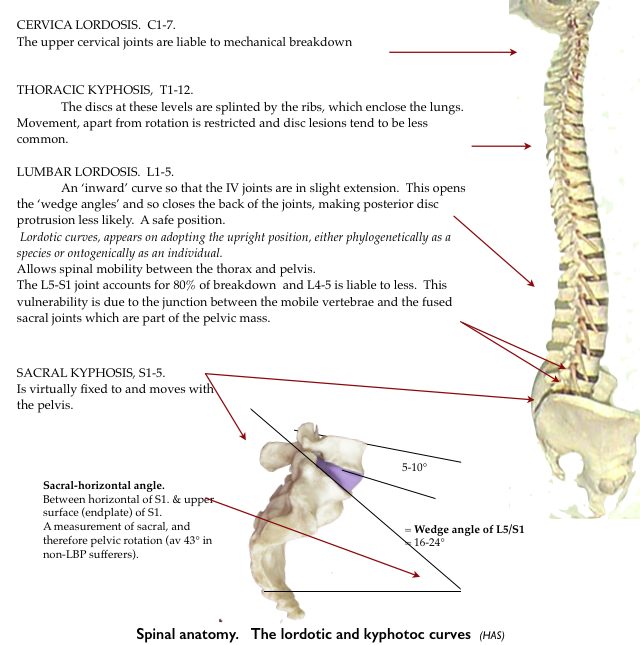
The foetal spine has a kyphotic C shape before birth which straightens up by incorporating lordotic changes at the two spinal levels. It is not straight as in most plantigrade animals although this need not be a biomechanic disadvantage in an orthograde context except would not allow an adequate birth canal. For further account, see Paleo-anthropology⟶
The Motion Segment.
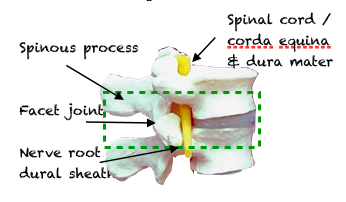 A motion segment consists of the joint, the intervertebral disc (IVD), between the vertebra above and the vertebra below (outlined in green). Included are a pair of associated joints (Zygapophyseal, facet) and various ligaments. The segment is traversed by a number of important structures (Nerve roots, dura mater, ligaments). The pathology of structures contained in a motion segment are responsible for symptomatology . This may vary from backache to sciatica and to a serious equina syndrome. Breakdown occurs mainly at the lower lumbar joints ( L4/5 & L5/S1) which are highly mobile and at the junction with the immobile mass of the pelvis. The structures most commonly involved are the posterior spinal ligaments and the inter-vertebral disc (IVD).
A motion segment consists of the joint, the intervertebral disc (IVD), between the vertebra above and the vertebra below (outlined in green). Included are a pair of associated joints (Zygapophyseal, facet) and various ligaments. The segment is traversed by a number of important structures (Nerve roots, dura mater, ligaments). The pathology of structures contained in a motion segment are responsible for symptomatology . This may vary from backache to sciatica and to a serious equina syndrome. Breakdown occurs mainly at the lower lumbar joints ( L4/5 & L5/S1) which are highly mobile and at the junction with the immobile mass of the pelvis. The structures most commonly involved are the posterior spinal ligaments and the inter-vertebral disc (IVD).
The anatomy of the Intervertebral Disc. 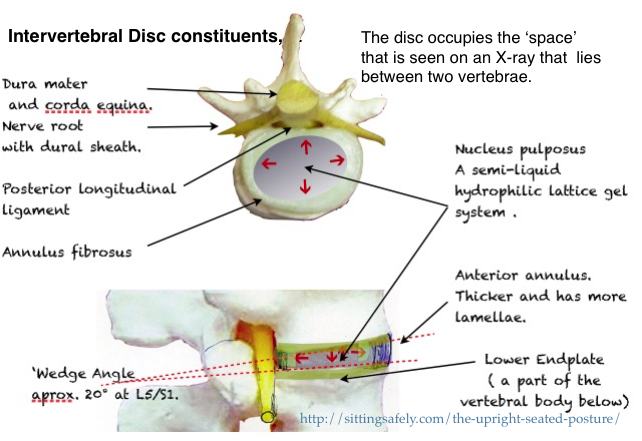 The intervertebral disc joins two adjacent vertebral bodies allowing the vertebra to move in relation to each other. Individual joint ranges have been given ( excluding the flexion due to pelvic rotation) as are L1 8°, L2 10°, L3 13°, L4 16° & L5/S1 17° (Weingarden DS 1991). It is the sum of ranges at each joint that accounts for the total range of lumbar spinal movement which is very variable depending on age, activities, genetics. Next continue and see details ☛ Intervertebral Disc (IVD) →
The intervertebral disc joins two adjacent vertebral bodies allowing the vertebra to move in relation to each other. Individual joint ranges have been given ( excluding the flexion due to pelvic rotation) as are L1 8°, L2 10°, L3 13°, L4 16° & L5/S1 17° (Weingarden DS 1991). It is the sum of ranges at each joint that accounts for the total range of lumbar spinal movement which is very variable depending on age, activities, genetics. Next continue and see details ☛ Intervertebral Disc (IVD) →
Spinal Ligaments
Connect the vertebrae and play an important part in providing the stability of the spine and protection of the disc.A number of midline vertical spinal ligaments lie posteriorly to the lumbar joints. Their function is to limit excessive flexion, and other, movement (but vide infra). They can also give rise to pain and, being visco-elastic, can be permanently lengthened by stretch. It is possible that ligament stretching in childhood leading to joint instability may be an associated cause of IV Disc degeneration and fundamental to the epidemic of adult spinal breakdown. See details ☛ Ligaments→
Spinal muscles and their stabilising effect.
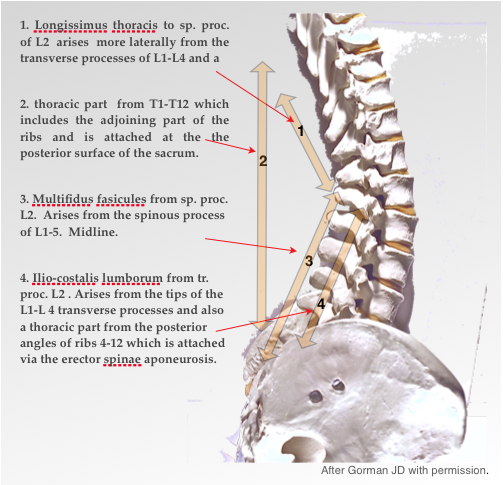 While ligaments provide passive restraint at the end of joint range, reflex muscle action also provide dynamic support in preserving the integrity and movers at joints including those of the spine. For details of muscle function ☛Muscles
While ligaments provide passive restraint at the end of joint range, reflex muscle action also provide dynamic support in preserving the integrity and movers at joints including those of the spine. For details of muscle function ☛Muscles
Disc Nutrition & Spinal Movement.
Spinal movement & change of position are important for a number of reasons including IV disc nutrition. For details see ☛see Disc nutrition
Intervertebral disc angles at the lumbar-sacral junction.
Spinal configuration of the intervertebral disc angles at the lumbar-sacral junction is important for preventing IV Disc pathology and developed as a result of hominins adopting an upright (orthograde) stance for efficient bipedalism. Lordosis at the vulnerable lumbar-sacral junction increased and this also protected the joints. For details see ☛ Disc (IVD) angles→
-
Next ☛ The Intervertebral Disc. (IVD)→

